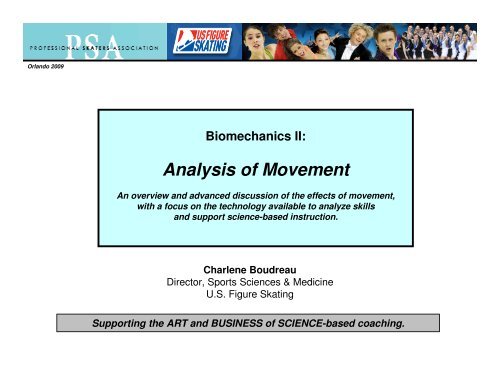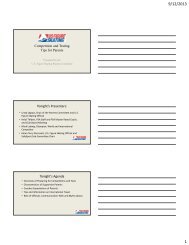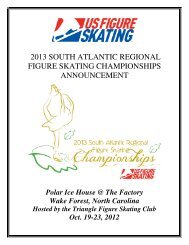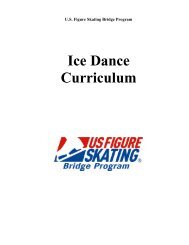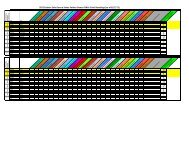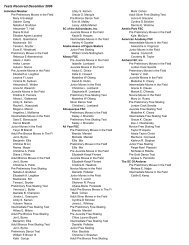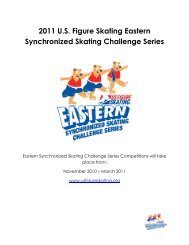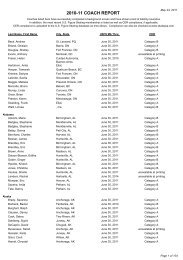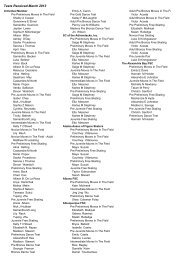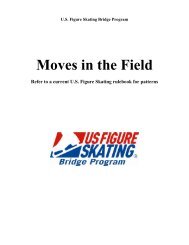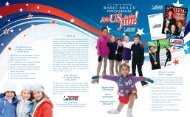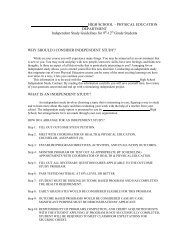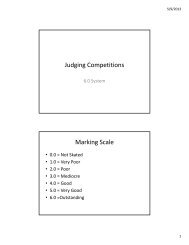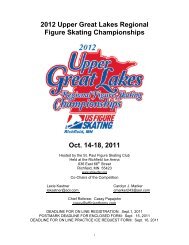Analysis of Movement - US Figure Skating
Analysis of Movement - US Figure Skating
Analysis of Movement - US Figure Skating
Create successful ePaper yourself
Turn your PDF publications into a flip-book with our unique Google optimized e-Paper software.
Orlando 2009<br />
Biomechanics II:<br />
<strong>Analysis</strong> <strong>of</strong> <strong>Movement</strong><br />
An overview and advanced discussion <strong>of</strong> the effects <strong>of</strong> movement,<br />
with a focus on the technology available to analyze skills<br />
and support science-based instruction.<br />
Charlene Boudreau<br />
Director, Sports Sciences & Medicine<br />
U.S. <strong>Figure</strong> <strong>Skating</strong><br />
Supporting the ART and B<strong>US</strong>INESS <strong>of</strong> SCIENCE-based coaching.
Technique is largely determined by mechanical factors.<br />
Some common technique tips…<br />
1. Gut-Butt Connection<br />
2. Alignment!<br />
3. Two-head turn to the top.<br />
4. …<br />
5. …<br />
6. …
In order to teach a new skill and/or coach an existing one,<br />
we must establish some sense <strong>of</strong> flow in movement/skill analysis.<br />
MECHANICALLY, what do I see in the skill?<br />
Is it good?<br />
Is it bad?<br />
Why is it happening?<br />
MASS - DISTANCE - TIME<br />
Is it important?<br />
Is it mental?<br />
Is it physiological?<br />
How can I fix it?<br />
Is the body size<br />
APPROPRIATE?<br />
Top 3 Precautions to Avoid Missing the Mark:<br />
1. Don’t Lose it in Translation.<br />
2. Prioritize Feedback.<br />
3. Focus on Critical Features (AP-MM).<br />
Are the muscles<br />
SMART enough?<br />
Are the muscles<br />
FUELED enough?<br />
A prelude to… Deterministic Modeling.
PRINCIPLES OF<br />
SKILL ANALYSIS<br />
SCIENCE-BASED INSTRUCTION<br />
Deterministic Modeling<br />
shows relationships<br />
between the result <strong>of</strong> a<br />
performance and the<br />
factors contributing to it.<br />
Time in air<br />
Jump Success<br />
V R<br />
in air<br />
Rhythm/<br />
Timing<br />
The method is used to:<br />
Take-<strong>of</strong>f<br />
angle<br />
Horizontal<br />
momentum<br />
Angular<br />
momentum<br />
Moment <strong>of</strong><br />
inertia<br />
Time to<br />
position<br />
Focus, objectify and prioritize training<br />
emphasis and feedback.<br />
V H<br />
and V V<br />
at take-<strong>of</strong>f<br />
Body<br />
Mass<br />
V H<br />
on<br />
approach<br />
Body position<br />
Physique<br />
Improve understanding <strong>of</strong> factors<br />
contributing to sport performance.<br />
Identify factors that are most sensitive<br />
to training/overtraining effects.<br />
Entry<br />
pattern<br />
Leg force<br />
Guide equipment design and rule<br />
changes.<br />
Guide quantitative research.<br />
Critical Features<br />
©CHARSolutions, LLC<br />
Critical Features describe specific body movements which may be observed<br />
in order to determine if the mechanical factors have been performed ideally.
PRINCIPLES OF<br />
SKILL ANALYSIS<br />
SCIENCE-BASED INSTRUCTION<br />
Deterministic Modeling is a Three-Step Process:<br />
Step 1 – Identify the errors associated with critical features.<br />
• Determine mechanical factors affecting the execution <strong>of</strong> the skill.<br />
• Identify true deterministic factors, ie those not directly connected to any lower factor.<br />
• Eliminate factors athlete cannot affect in time frame being considered.<br />
• Observe athlete performance on remaining factors.<br />
Step 2 – Evaluate and prioritize the errors.<br />
• Maximize impact subject to motivational needs.<br />
• Important factors are those strongly related to the result.<br />
• Sensitive factors are those that can change.<br />
• Exclude errors that appear to be caused by other errors.<br />
• Consider time frame.<br />
Step 3 – Intervene via feedback, practice, training.<br />
Implementation<br />
Pre-requisites:<br />
What makes a difference?<br />
What can change?<br />
How long might it take?<br />
How do I go about it?<br />
TECHNOLOGY CAN HELP!!!
PRINCIPLES OF<br />
ANALYSIS OF<br />
MOVEMENT<br />
Research – Casey, King & Smith<br />
About 10 years ago, there was a study done on the characteristics<br />
most critical to successful completion <strong>of</strong> the triple axel.<br />
Speed <strong>of</strong> rotation, jump height, jump distance were investigated.<br />
Skaters with rotation speeds <strong>of</strong> 5 rev/sec or more were more<br />
successful in completing triple axels.<br />
THE RESULTS<br />
Jump heights were not appreciably different among singles, doubles<br />
and triples!<br />
Take-<strong>of</strong>fs and jump distances were shortest for triples, probably due<br />
to larger skids. Skid widths ranged from 1.25 to 3.00 inches.<br />
Time to bring arms and legs into tightest position was a major factor in<br />
rotational speed.<br />
Axel Rotational Velocity (m/s)<br />
Single Double Triple<br />
3.6 4.5 5.0<br />
2.5 4.1 4.6<br />
2.4 4.5 4.7<br />
2.8 4.1 5.4<br />
3.2 4.1 5.0<br />
The application <strong>of</strong> biomechanics principles minimizes “trial and error” coaching and fosters the development <strong>of</strong> effective<br />
teaching strategies and training programs that are specific to the unique needs <strong>of</strong> individual skaters and teams.
PRINCIPLES OF<br />
ANALYSIS OF<br />
MOVEMENT<br />
Research – Casey, King & Smith<br />
Frames (30 fps)<br />
Time in Air (s)<br />
Jump Ht (in)<br />
Jump Ht (m)<br />
Triple Zone Ladies<br />
Triple Zone Men<br />
10<br />
0.333<br />
5.4<br />
0.14<br />
11<br />
0.367<br />
6.5<br />
0.16<br />
This research team<br />
defined the relationship<br />
between jump height, time<br />
in air and number <strong>of</strong> video<br />
frames during the flight <strong>of</strong><br />
a jump.<br />
12<br />
13<br />
14<br />
15<br />
16<br />
17<br />
0.400<br />
0.433<br />
0.467<br />
0.500<br />
0.533<br />
0.567<br />
7.7<br />
9.1<br />
10.5<br />
12.1<br />
13.7<br />
15.5<br />
0.20<br />
0.23<br />
0.27<br />
0.31<br />
0.35<br />
0.39<br />
18<br />
0.600<br />
17.4<br />
0.44<br />
These values assume that the skater’s<br />
center <strong>of</strong> mass is at the same height at<br />
take-<strong>of</strong>f and landing.<br />
19<br />
20<br />
21<br />
0.633<br />
0.667<br />
0.700<br />
19.4<br />
21.5<br />
23.7<br />
0.49<br />
0.55<br />
0.60<br />
22<br />
0.733<br />
26.0<br />
0.66<br />
23<br />
0.767<br />
28.4<br />
0.72<br />
24<br />
0.800<br />
30.9<br />
0.78<br />
25<br />
0.833<br />
33.5<br />
0.85<br />
26<br />
0.867<br />
36.3<br />
0.92<br />
The application <strong>of</strong> biomechanics principles minimizes “trial and error” coaching and fosters the development <strong>of</strong> effective<br />
teaching strategies and training programs that are specific to the unique needs <strong>of</strong> individual skaters and teams.
PRINCIPLES OF<br />
ANALYSIS OF<br />
MOVEMENT<br />
Projectile Motion<br />
“An object that leaves a surface with<br />
both horizontal and vertical velocity will<br />
follow a parabolic or symmetrical arcshaped<br />
pattern in the air.”<br />
TRANSLATION: The up and down<br />
parts <strong>of</strong> the flight path <strong>of</strong> a skater’s<br />
jump will be symmetrical.<br />
“The greater the height <strong>of</strong> the<br />
trajectory, the longer the air time<br />
associated with the parabola.”<br />
TRANSLATION: The higher you go,<br />
the more time you get to spend in the<br />
air. (Imagine a water hose!)<br />
The application <strong>of</strong> biomechanics principles minimizes “trial and error” coaching and fosters the development <strong>of</strong> effective<br />
teaching strategies and training programs that are specific to the unique needs <strong>of</strong> individual skaters and teams.
PRINCIPLES OF<br />
ANALYSIS OF<br />
MOVEMENT<br />
Projectile Motion<br />
The specific flight path a skater<br />
follows is determined by the<br />
velocity and angle at take-<strong>of</strong>f.<br />
Important Factors:<br />
Approach speed (V H<br />
)<br />
Upward press (V V<br />
)<br />
There may be a trade <strong>of</strong>f between<br />
jump height and rotational<br />
velocity.<br />
You need enough time to complete<br />
the rotations, pull in arms and<br />
legs, open to check out for landing,<br />
and to distribute rotations equally.<br />
The application <strong>of</strong> biomechanics principles minimizes “trial and error” coaching and fosters the development <strong>of</strong> effective<br />
teaching strategies and training programs that are specific to the unique needs <strong>of</strong> individual skaters and teams.
PRINCIPLES OF<br />
ANALYSIS OF<br />
MOVEMENT<br />
Conservation <strong>of</strong> Rotational Momentum<br />
Rotational momentum quantifies the amount <strong>of</strong><br />
rotational motion that a skater possesses about her axis <strong>of</strong><br />
rotation (usually longitudinal axis).<br />
Since rotational momentum remains constant…<br />
If moment <strong>of</strong> inertia ↑, then rotational velocity ↓.<br />
If moment <strong>of</strong> inertia ↓, then rotational velocity ↑.<br />
<br />
<br />
<br />
<br />
Rotational momentum is created during the entrance<br />
to a spin or during a jump preparation and take-<strong>of</strong>f.<br />
It combines both how fast a skater is rotating and the<br />
current body position:<br />
Rotational momentum = V R X moment <strong>of</strong> inertia<br />
On the ice, rotational momentum is created when the<br />
forces the skater applies to the ice with her blade<br />
create a torque.<br />
Once in the air, however, there is no surface for the<br />
skater to push against, so rotational momentum<br />
remains constant from jump take-<strong>of</strong>f until landing.<br />
The greater the rotational momentum going into a<br />
jump or spin, the greater potential for rotational<br />
velocity during the jump or spin.<br />
The best jump take-<strong>of</strong>fs and spin entries are ones<br />
that convert horizontal velocity into vertical velocity<br />
and initiate rotation.<br />
The greater the rotational momentum going into a<br />
jump or spin, the harder it will be to pull the arms and<br />
legs into a tight position and hold it.<br />
Enter strength, timing, skids, patterns, take-<strong>of</strong>f<br />
movements, air position, etc.<br />
The application <strong>of</strong> biomechanics principles minimizes “trial and error” coaching and fosters the development <strong>of</strong> effective<br />
teaching strategies and training programs that are specific to the unique needs <strong>of</strong> individual skaters and teams.
ANALYSIS<br />
TECHNOLOGY<br />
MOTION ANALYSIS<br />
In 1999, a motion analysis<br />
program was developed at the<br />
University <strong>of</strong> Delaware.<br />
Technical, logistical and<br />
financial complications forced<br />
it closed.<br />
With support <strong>of</strong> the United<br />
States Olympic Committee<br />
and U.S. <strong>Figure</strong> <strong>Skating</strong>, the<br />
University <strong>of</strong> Delaware is<br />
reviving the program.<br />
The new motion analysis program<br />
continues to focus on the mechanical<br />
determinants <strong>of</strong> multi-revolution jumps:<br />
• Body measurements (anthropometrics)<br />
• Rotational energy at take-<strong>of</strong>f (angular<br />
momentum)<br />
• Body position in air (moment <strong>of</strong> inertia)<br />
• Jump height (air time)<br />
The new program boasts<br />
modern s<strong>of</strong>tware and new<br />
personnel with the abilities to:<br />
• Analyze critical features<br />
• Assess revolution capacity<br />
• Provide real-time analysis<br />
• Suggest strategies<br />
• Evaluate strategies<br />
• Develop norms<br />
Imagine all the “What if”<br />
scenarios!!
ANALYSIS<br />
TECHNOLOGY<br />
Closer to home…<br />
Affordable.<br />
Friendly.<br />
EFFECTIVE!


